Local Road Research Board News
October 2024
 GUIDEBOOKS
Best Practices for Boulevard Tree Selection

Trees planted in the boulevard along a roadway offer valuable environmental benefits. They lower temperatures, reduce greenhouse gases, reduce stormwater runoff, and improve aesthetics. However, boulevards are often a difficult location to plant trees because of the limited space, utility conflicts, and salt residue from winter maintenance. Additionally, residents may be concerned about who is responsible for the cost, care and maintenance. This guidebook recommends best practices for selecting, planting and caring for street trees based on the experience of local agencies in Minnesota. It also includes communication strategies to encourage the support of residents.
|
Pavement Design Around Utilities
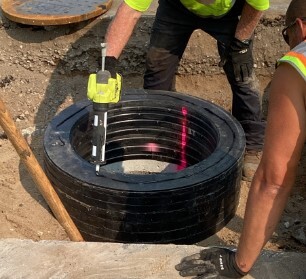
Asphalt concrete pavement surrounding utility covers is prone to settlement, cracking, breaking up, and potholing, which can lead to ride quality issues and hazards for vehicles and snowplows. These distresses are common in Minnesota’s wet-freeze climate. Several factors contribute to their formation including design requirements, collar material type and cut shape, construction practices, frost heave, and backfill settlement. This guidebook documents local agency best practices for improving design and maintenance of asphalt concrete pavement around utility covers. It highlights successful and unsuccessful regional practices, factors contributing to pavement damage, timing of inspections and maintenance, and a framework for evaluating and modifying practice.
|
Pavement Marking Retroreflectivity
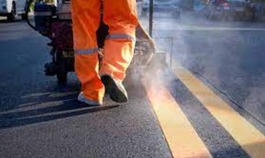
To reduce highway fatalities after dark, the U.S. Federal Highway Administration issued new requirements for pavement marking “retroreflectivity” (the measure to which pavement markings reflect headlamp light back to its source). This standard has been incorporated into the Minnesota Manual on Uniform Traffic Control Devices and applies to all agencies that manage Minnesota roadways. New guidance provided in a webinar format offers an easy-to-understand review of what agencies need to know to comply with new standards. It includes the basics of retroreflectivity; review and summary of current requirements, deadlines, and procedures; and exploration of tools, methods, and techniques to achieve retroreflectivity goals.
|
NEW RESEARCH

Preventing right turns on red at traffic signals is generally an effective pedestrian safety measure. But when pedestrians are absent, allowing right turns on red can improve traffic flow. Unlike static signs that prohibit right turns on red, dynamic No Right Turn on Red signs can be activated when pedestrians are present or at certain times of the day. Researchers compared driver compliance with dynamic and static signs and learned that each sign type may have its own benefits.
|
Assessing Pavement Markings for Automated Vehicle Readiness
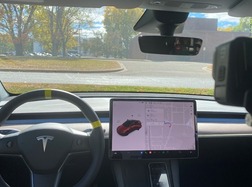
Blind spot monitoring, lane departure warnings and adaptive cruise control are among the functions of automated vehicles (AVs) with significant potential safety benefits. To accurately function, lane-keep systems rely on camera-based sensors to detect pavement markings and help a vehicle track the roadway lanes. New research increases understanding of pavement marking design qualities that optimize AV function. Field observations in different locations and during the day and at night using different data collection methods allowed researchers to evaluate the impact of various pavement marking properties on AV lane-keeping functions. Results support MnDOT in producing pavement marking guidance that is responsive to changing needs.
|
Max-Pressure Signal Timing on Minnesota Roads
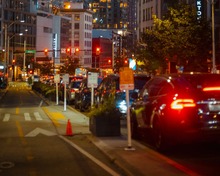
Traffic signal timing can be a primary cause of congestion and increased travel times. Max-pressure traffic signal control, a new signal timing method, detects entire vehicle queues waiting to cross and exit an intersection and uses a mathematically proven algorithm to maximize vehicles moving through to minimize delays. Some issues that would make implementation impractical needed to be resolved before it can be tested. To address those concerns in preparation for a pilot study, researchers modified the original model and simulated its performance using data and parameters from intersections in Hennepin County. The result was significantly reduced delays and more traffic moving through the intersections as compared to the current signal controls.
|
FUNDING OPPORTUNITY
$12.5 Million in Grants Available for Greater Minnesota Projects

Minnesota communities are invited to apply for funding for local projects that enhance transportation goals including pedestrian and bicycle facilities, historic preservation, Safe Routes to School and more. The Minnesota Department of Transportation announced that nearly $12.5 million is available in federal grants through the Transportation Alternatives program in Greater Minnesota. Each region has a sub-targeted fund. Applicants must first submit a letter of intent by Nov. 1, 2024, to be considered for the 2024-25 solicitation. Go to the Transportation Alternatives website for grant details.
|
UPCOMING EVENTS
Webinar: Updating the Minnesota Stormwater Inspection and Maintenance Resource Guide
Center for Transportation Studies, Thursday, Oct. 31, Noon to 1:30 p.m.

Learn about an LRRB project to update, revise, and expand the 2009 Stormwater BMP Inspection and Maintenance Resource Guide. Andrew Erickson, University of Minnesota, will discuss the update which incorporates more than a decade’s worth of knowledge gained. Additions include guidance on inspection and maintenance on iron-enhanced sand filters and nutrient release from bioretention-based practices and stormwater ponds, among others.
|
Webinar: Stay in Your Lane - App to Warn Drivers of Unintentional Lane Departures
Local Road Research Board, Thursday, Nov. 14, Noon to 1 p.m.

Unintentional lane departure is a significant safety risk. Currently, available commercial lane departure warning systems use vision-based or GPS technology with lane-level resolution. These techniques have their own performance limitations in poor weather conditions. Join Imran Hayee, principal investigator, and Victor Lund, technical liaison, to learn about a LRRB project that addresses those limitations with the development of an innovative lane departure detection app that provides real-time warnings to drivers.
|
Conferences & Training
-
Chainsaw Safety Training for Local Agencies, MnLTAP, Oct. 14, 16 & 17, locations around the state
-
Minnesota Water Resources Conference, University of Minnesota, Oct. 15-16. St. Paul RiverCentre
-
2024 Build A Better Mousetrap National Award Winners, Oct. 17, webinar
-
Local Road Conference, North Dakota LTAP, Oct. 21-23, Sioux Falls
-
2024 Towards Zero Deaths Conference, Oct. 22-23, St. Cloud
-
Minnesota Truck-Weight Education Training, MnLTAP, Oct. 21, 28 & 29, Nov. 4 & 13, locations around the state
-
Minnesota Snowplow and Safety Simulator Training for Local Agencies, MnLTAP, Dec. 4, 6 & 10, locations around the state
PROJECT SHOWCASE
Build a Better Mousetrap Competition Winners
Congratulations to the recipients of Minnesota’s 2024 Build a Better Mousetrap Awards! The Minnesota Pioneer Award goes to Roseau County for its Belly Plow Safety Access Step, and the Minnesota SMART Transformation Award goes to Oak Lawn Township for its Belly Scratcher.
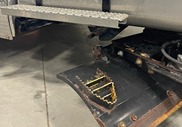
Belly Plow Access Step: In snowy or wet conditions, the steps on plow trucks can become slippery. Roseau County wanted to reduce the slip-and-fall hazard. A staff member welded a grip pad onto the upper surface of the belly plow, which made it significantly easier to access the truck’s cab. For under $100, this additional grip step makes getting into and out of a plow truck much safer in slippery conditions.
|
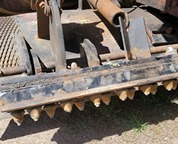
Belly Scratcher: Oak Lawn Township had problems maintaining its gravel roads. In the winter, they became glazed-over and icy, and salt/sand would not stay in the travel lanes. In the summer, small washboards would develop on the roads treated with calcium chloride used to control dust. A maintenance employee built the Belly Scratcher for about $1,500 and solved the issues. In the winter, the grooves cut by the scratcher keep salt/sand in place, resulting in smooth, less slippery surfaces. Salt/sand usage also dropped by one-third. In the summer, the attachment levels rough spots without destroying the calcium chloride.
The Minnesota Build a Better Mousetrap Competition recognizes local transportation innovations by highlighting homegrown ideas, equipment modifications, and safety improvements. Show off your creativity and help other agencies solve problems by submitting your local innovations! The competition is sponsored by the LRRB and administered by Minnesota LTAP.
|
LRRB UPDATES
Fall Prescreening Meetings
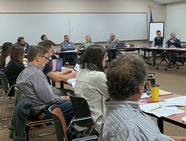
See you at the LRRB listening sessions at the October Prescreening Meetings scheduled around the state! We're looking forward to hearing from city and county public works professionals about your challenges and ideas for future research.
|
LRRB Projects at CTS Transportation Research Conference
Are you attending the CTS Transportation Research Conference on Nov. 7? Check out the LRRB projects that will be featured:
Sheila Hatchell Retires from MnDOT Library

Sheila Hatchell, director of the MnDOT Library, retired in September after 17 years in that position. During her tenure, Sheila had many accomplishments. In 2010-2011, she oversaw the renovation of the library space, a project that received the American Library Association's John Cotton Dana Public Relations Award. In 2012, she co-authored Proving Your Library’s Value: A Toolkit for Transportation Libraries. Sheila led an initiative to make more library materials available digitally, an effort that became critical during the pandemic. The library team launched an eBooks collection and MnDOT Digital Library. Earlier this year, Sheila received the 2024 Professional Achievement Award from the Special Libraries Association after being nominated by her peers. We thank Sheila for her many contributions to LRRB and MnDOT and wish her all the best in her retirement.
|
NOW HIRING
Minnesota LTAP Training and Technical Instructor
Reporting to the director of Training and Technical Assistance at the Center for Transportation Studies, which houses MnLTAP, this position manages, administers, and provides training and technical expertise to local agencies across Minnesota. Responsibilities include conducting training and providing technical assistance, developing and updating curriculum and training materials for the program, managing part-time training staff and training schedules, and building and maintaining relationships with MnLTAP stakeholders.
 Minnesota Local Road Research Board • lrrb.org
|